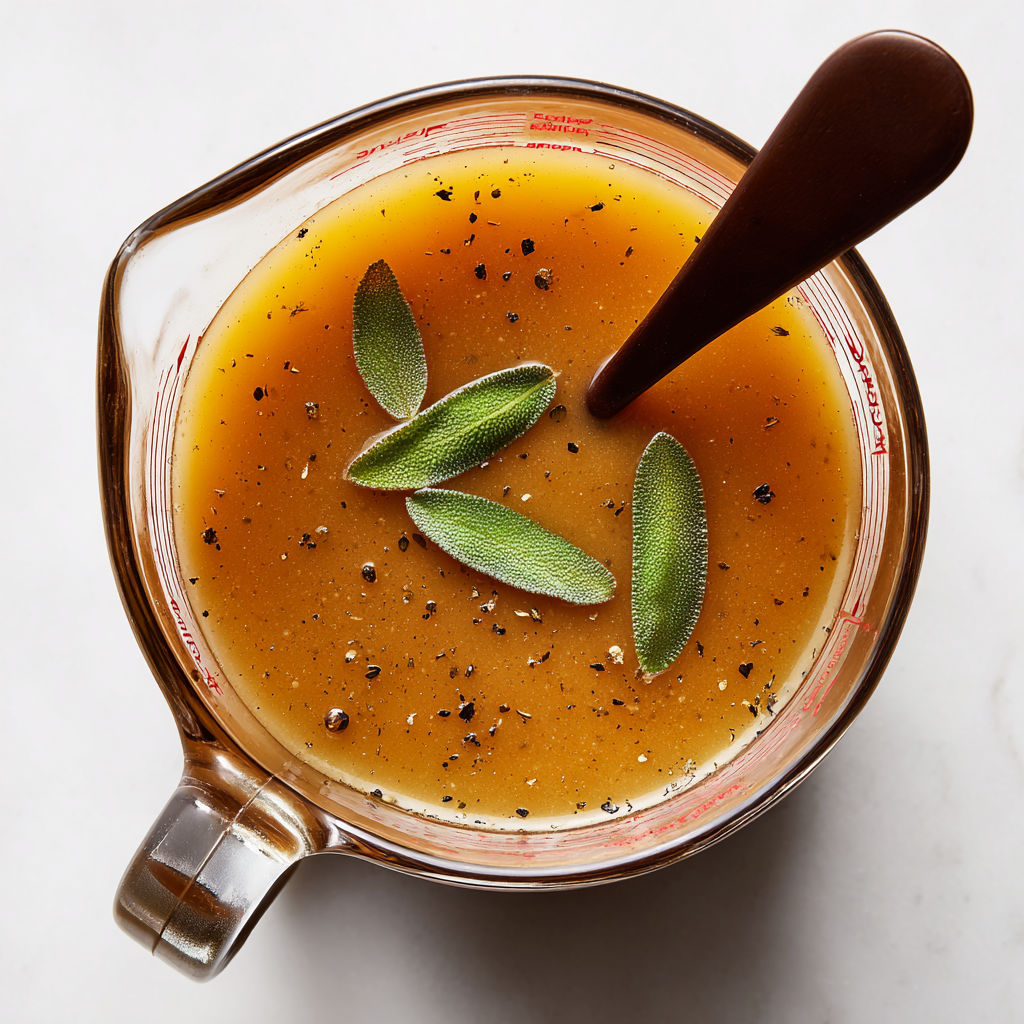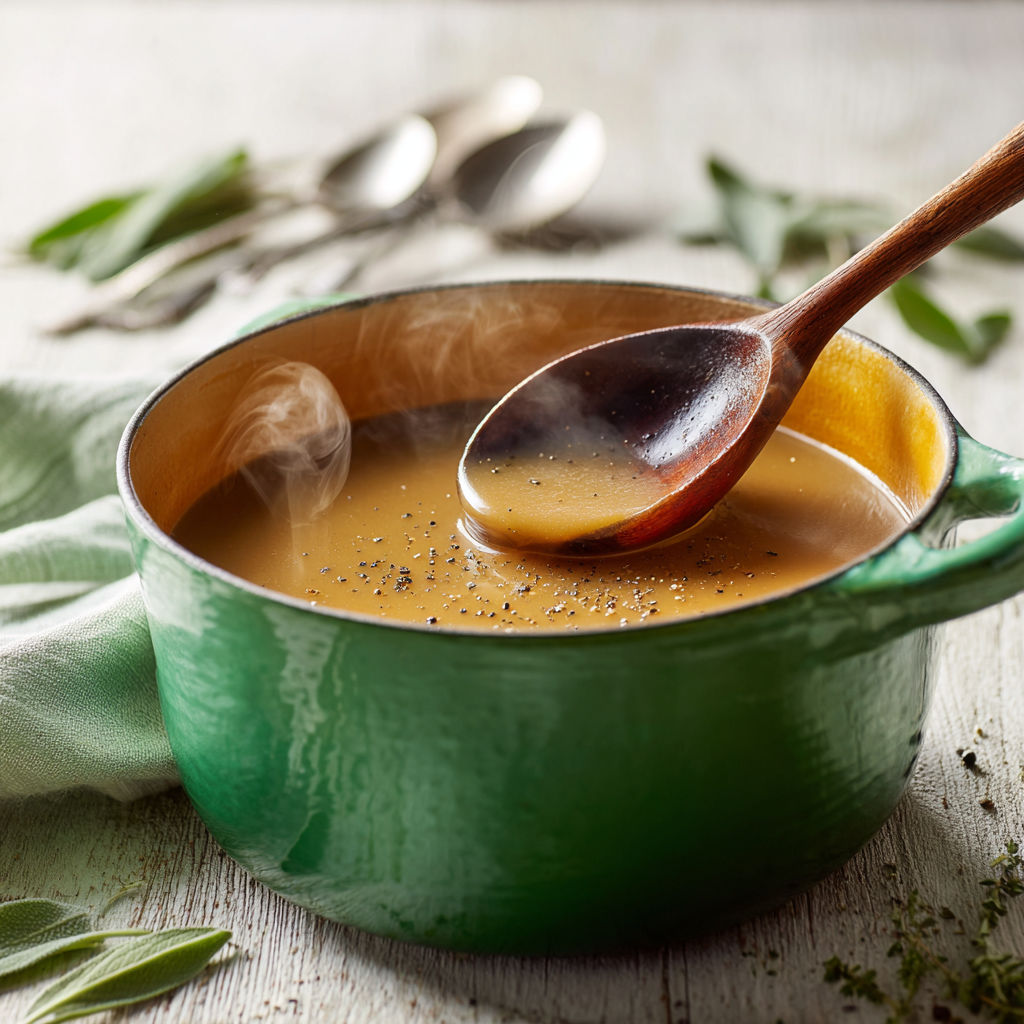 Pin
Pin
This cider and sage gravy recipe has completely changed the way I serve holiday meals, bringing a bright herbal twist to classic Thanksgiving gravy ideas in under an hour of prep and cooking. Real apple cider and fresh sage infuse every spoonful with cozy autumn flavors, making this the perfect herb gravy for spreading over stuffing, mashed potatoes, or any easy weeknight roast. With just 25 minutes of prep time and a cook time ranging from 45 to 60 minutes, you can have an elegant, deeply flavorful sage gravy recipe on the table without stress.
I first made this cider and sage gravy when my sister requested something vibrant and fresh for Thanksgiving, searching for gravy recipes with a twist. The aroma of sage leaves and apples mingling with butter drew everyone to the kitchen begging for tastes directly from the pan. It has become our most requested fresh herb gravy for any special meal, thanks to its ability to brighten the whole table with simple ingredients and classic autumn flavors.
Gather Your Ingredients
- Unsalted butter for gravy recipes: Gives a silky, restaurant style finish; use high quality butter for best flavor, or substitute part with olive oil for a richer or dairy free option
- Finely diced onion savory base: Adds natural sweetness and depth; sweet or yellow onions blend best, and shallots can be used for a milder profile
- Large clove garlic minced aromatic: Brings warmth and layered aroma; always mince finely for even distribution, or substitute with a small shallot
- All purpose flour to thicken gravy: Creates a smooth, thick texture; use gluten free all purpose flour for a gluten friendly version without sacrificing consistency
- Apple cider fresh autumn flavor: Infuses gentle sweetness and tang; opt for cloudy, fresh pressed cider for the richest taste, or swap for pear cider or a dash of white wine
- Worcestershire sauce umami depth: Rounds out flavors with subtle savoriness; look for vegetarian Worcestershire if making meatless herb gravy
- Kosher salt seasoning: Essential for balancing flavors; always taste after adding stock to avoid overseasoning, especially if using pre salted broth
- Chicken stock or vegetable stock base: Forms the savory backbone of herb gravy; use homemade or low sodium for best results, swap vegetable stock for vegetarian or stuffing gravy ideas
- Large handful fresh sage leaves: The key to bold herb flavor; choose plump, vibrant leaves, either tied in a bundle or chopped, about a quarter cup loosely packed
- Freshly ground black pepper finishing touch: Adds mild bite and lively aroma; grind fresh and add at the end for the most fragrance
How to Make Cider and Sage Gravy
- Sauté the Aromatics for Maximum Flavor:
- Add 1 tablespoon unsalted butter to a heavy bottomed pan, then toss in the diced onions. Sauté gently over low to medium heat for 30 to 40 minutes, stirring often until onions turn deep golden brown and sweet. Long caramelization is crucial here to develop a deeply savory, naturally sweet flavor base—avoid rushing and add a splash of water if onions stick.
- Build an Aromatic Base with Garlic:
- Sprinkle in the minced garlic and sauté for 1 to 2 minutes just until fragrant and the raw edge fades. Stir continuously to prevent burning; this helps build subtle aromatic warmth fundamental to great holiday gravy recipes.
- Toast the Flour for a Flavorful Roux:
- Add the remaining butter to melt, then sprinkle in all purpose flour slowly, stirring or whisking constantly. Cook the roux for 10 to 15 minutes, watching as it deepens to a rich amber brown. This crucial step eliminates any raw flour taste and ensures a smooth, glossy gravy every time.
- Deglaze and Layer in the Apple Cider:
- Slowly pour in the apple cider while stirring to dissolve all the flour and roux. Add Worcestershire sauce and salt, making sure the mixture is lump free and shiny—this creates a balanced sweet and savory foundation that shines in every spoonful.
- Simmer with Stock and Sage:
- Gradually pour in chicken or vegetable stock, continuing to whisk, then add the sage bundle or chopped sage. Bring the mixture to a gentle simmer—not a rolling boil—and infuse flavors for 10 minutes. The gravy should thicken to coat the back of a spoon, looking velvety and rich. Season with pepper and more salt as needed for a perfect finish.
- Finish and Serve or Make Ahead:
- If making in advance, let the gravy cool before transferring to airtight containers. Store in the refrigerator and reheat gently over low heat, adding a splash of stock or cider if thickened too much. This recipe yields about 1 quart, ample for covering mains, sides, or saving as meal prep after a festive dinner.

My favorite part of this herb gravy recipe is how the fresh sage perfumes the whole kitchen while simmering gently on the stove. I remember my kids hovering nearby, drawn in by the scent, and begging for tastes before dinner—now they always request a double batch for the holidays. Discovering how antioxidants from sage and onions plus vitamin C in the cider can offer comfort and nourishment has made this a feel good classic for our family table.
Smart Swaps and Variations
Customizing this cider and sage gravy recipe is easy and makes it adaptable for any dietary need or festive occasion. Substitute olive oil for butter and use vegetable stock plus vegan Worcestershire to keep the gravy entirely plant based. Trade apple cider for pear juice or a splash of white wine to give the gravy a mild, fruity tang if you are missing cider. Gluten free flour works perfectly as a swap for the roux, ensuring everyone can enjoy a silky smooth gravy. For layered herb flavor, add thyme or parsley with the sage, or pour in a little cream just before serving for a richer finish.
How to Store and Reheat Cider and Sage Gravy
This cider and sage gravy is a reliable make ahead option for both holidays and weeknight meals. After cooling, store gravy in an airtight container in the fridge for up to four days. For longer term, portion cooled gravy in freezer safe containers and freeze up to three months—remember to thaw overnight in the fridge before reheating. Warm gravy on the stovetop over gentle heat, stirring frequently and adding a dash more stock or cider to refresh the texture. Making this gravy ahead saves valuable time and guarantees delicious results for planned and leftover meals alike.
What to Serve with Cider and Sage Gravy
This apple cider sage gravy ties together holiday feasts and comforts weeknight dinners alike. Pour generously over roasted turkey, chicken, or even a vegetarian nut roast for a festive centerpiece, and ladle over sides like mashed potatoes, stuffing, or roasted root vegetables for a true Thanksgiving gravy recipe experience. Pair with soft buttermilk biscuits or serve in a gravy boat for dipping seasonal vegetables and crusty bread. For a complete meal, match with spiced cider or a crisp white wine to highlight the gravy’s autumnal notes and elevate every bite.
Nutritional Benefits
Cider and sage gravy is a lighter, more wholesome alternative to heavy cream based gravies, thanks to the use of chicken or vegetable stock and only a modest amount of butter or olive oil. Fresh sage provides natural antioxidants, while apple cider brings gentle sweetness and a small boost of vitamin C. This herb gravy recipe is naturally vegetarian and easily vegan with simple swaps, and you can make it gluten free as needed. Compared to store bought gravy, it is lower in sodium and free from artificial additives, making it a nourishing homemade addition to any meal.
Recipe Success Tips
If you encounter lumps in your cider and sage gravy, simply blend with a stick blender or strain for a flawless finish. Always add salt gradually and taste as you go to prevent an overseasoned result, especially when using salty stock. Adjust thickness by simmering longer for a more substantial gravy or thinning with extra stock or cider to achieve that perfect, pourable texture every time. These techniques ensure a smooth, restaurant quality result even if it’s your first time making homemade gravy.

This cider and sage gravy breathes new life into stuffing, turkey, and every cozy side dish. Try it this holiday season for a flavor packed twist and enjoy the comforting aroma and taste that makes any meal feel special.
Common Questions About This Recipe
- → Can I use vegetable stock instead of chicken stock?
Absolutely. Swapping chicken stock for vegetable stock works well and makes the sauce suitable for vegetarians without sacrificing depth of flavor.
- → How do I achieve a smooth texture?
Whisk flour into the melted butter gradually and stir constantly while adding liquids to avoid clumps for a silky sauce.
- → Can this sauce be made ahead?
Yes. Prepare in advance, refrigerate, and gently reheat when needed. Add a splash of stock if it thickens too much upon cooling.
- → Is the cider flavor very strong?
The cider adds subtle acidity and sweetness without overpowering the other flavors. It balances beautifully with the sage and onions.
- → What dishes pair best with this gravy?
This sauce pairs wonderfully with turkey, chicken, stuffing, mashed potatoes, and roasted vegetables, especially during Thanksgiving or festive meals.
